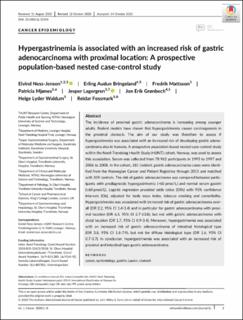| dc.contributor.author | Ness-Jensen, Eivind | |
| dc.contributor.author | Bringeland, Erling Audun | |
| dc.contributor.author | Mattsson, Fredrik | |
| dc.contributor.author | Mjønes, Patricia | |
| dc.contributor.author | Lagergren, Jesper | |
| dc.contributor.author | Grønbech, Jon Erik | |
| dc.contributor.author | Waldum, Helge | |
| dc.contributor.author | Fossmark, Reidar | |
| dc.date.accessioned | 2021-01-19T14:14:33Z | |
| dc.date.available | 2021-01-19T14:14:33Z | |
| dc.date.created | 2020-12-04T12:26:41Z | |
| dc.date.issued | 2020 | |
| dc.identifier.citation | International Journal of Cancer. 2020, . | en_US |
| dc.identifier.issn | 0020-7136 | |
| dc.identifier.uri | https://hdl.handle.net/11250/2723736 | |
| dc.description.abstract | The incidence of proximal gastric adenocarcinoma is increasing among younger adults. Rodent models have shown that hypergastrinemia causes carcinogenesis in the proximal stomach. The aim of our study was therefore to assess if hypergastrinemia was associated with an increased risk of developing gastric adenocarcinoma also in humans. A prospective population‐based nested case‐control study within the Nord‐Trøndelag Health Study (HUNT) cohort, Norway, was used to assess this association. Serum was collected from 78 962 participants in 1995 to 1997 and 2006 to 2008. In the cohort, 181 incident gastric adenocarcinoma cases were identified from the Norwegian Cancer and Patient Registries through 2015 and matched with 359 controls. The risk of gastric adenocarcinoma was compared between participants with prediagnostic hypergastrinemia (>60 pmol/L) and normal serum gastrin (≤60 pmol/L). Logistic regression provided odds ratios (ORs) with 95% confidence intervals (CIs), adjusted for body mass index, tobacco smoking and comorbidity. Hypergastrinemia was associated with increased risk of gastric adenocarcinoma overall (OR 2.2, 95% CI 1.4‐3.4) and in particular for gastric adenocarcinoma with proximal location (OR 6.1, 95% CI 2.7‐13.8), but not with gastric adenocarcinoma with distal location (OR 1.7, 95% CI 0.9‐3.4). Moreover, hypergastrinemia was associated with an increased risk of gastric adenocarcinoma of intestinal histological type (OR 3.8, 95% CI 1.8‐7.9), but not for diffuse histological type (OR 1.6, 95% CI 0.7‐3.7). In conclusion, hypergastrinemia was associated with an increased risk of proximal and intestinal type gastric adenocarcinoma. | en_US |
| dc.language.iso | eng | en_US |
| dc.publisher | John Wiley & Sons Ltd on behalf of Union for International Cancer Control. | en_US |
| dc.rights | Navngivelse 4.0 Internasjonal | * |
| dc.rights.uri | http://creativecommons.org/licenses/by/4.0/deed.no | * |
| dc.title | Hypergastrinemia is associated with an increased risk of gastric adenocarcinoma with proximal location: A prospective population-based nested case-control study | en_US |
| dc.type | Peer reviewed | en_US |
| dc.type | Journal article | en_US |
| dc.description.version | publishedVersion | en_US |
| dc.source.pagenumber | 0 | en_US |
| dc.source.journal | International Journal of Cancer | en_US |
| dc.identifier.doi | 10.1002/ijc.33354 | |
| dc.identifier.cristin | 1856230 | |
| dc.description.localcode | This is an open access article under the terms of the Creative Commons Attribution License, which permits use, distribution and reproduction in any medium, provided the original work is properly cited. | en_US |
| cristin.ispublished | true | |
| cristin.fulltext | original | |
| cristin.qualitycode | 2 | |

